Purchase order automation guide: How to automate PO processes
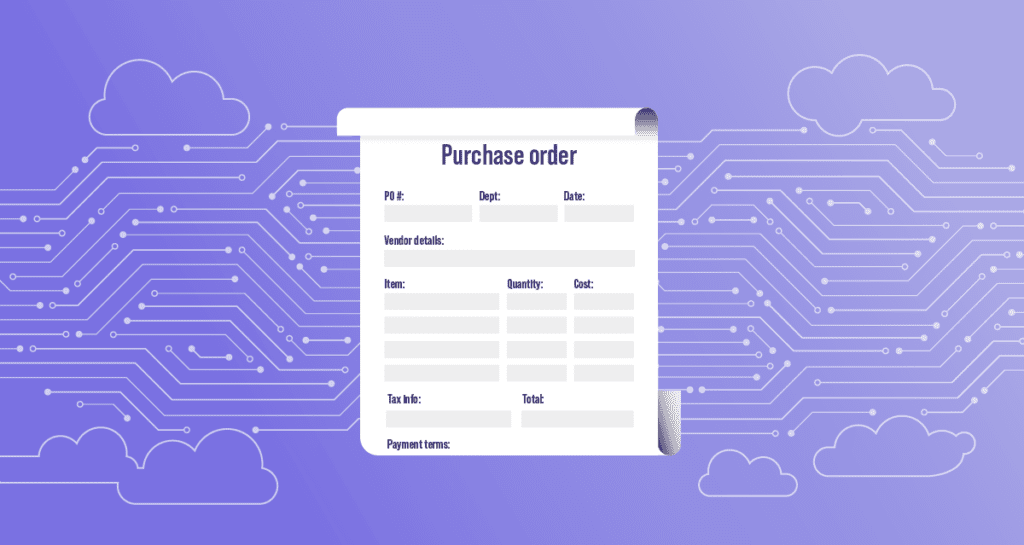
Optimizing your purchase order process can bring big benefits to your business, but where do you start?
Good purchase order management is central to maintaining a healthy supply chain. POs are binding legal contracts between your business and your suppliers. They must be accurate and timely to ensure efficient procurement. Internally, POs are vital for monitoring and controlling purchases and expenses and managing cash flow.
Purchase order automation is compelling for finance managers. It promises to save time and money, streamline inefficient manual processes, reduce errors and fraud, and improve payment times. However, the prospect of automating the entire purchase-to-payment workflow can be daunting for many businesses. It’s no wonder why choosing the wrong solution could potentially create more inefficiencies than it solves.
The good news is that it doesn’t have to be complicated.
In this guide, we help you make informed decisions about PO automation by:
- Exploring the benefits of using purchase order automation technologies like AI and machine learning.
- Discussing which steps in the purchase order process can (and can’t) be automated.
- Sharing practical steps you can take to improve your procurement process without disrupting your business.
Whether you’re looking to strengthen financial control, reduce costs, or boost efficiency, you’ll have a powerful tool to transform your purchase order processes.
What is purchase order automation?
According to Statista, 36% of manufacturers worldwide invested in purchase order automation in 2022, making it the third-largest digital procurement investment.
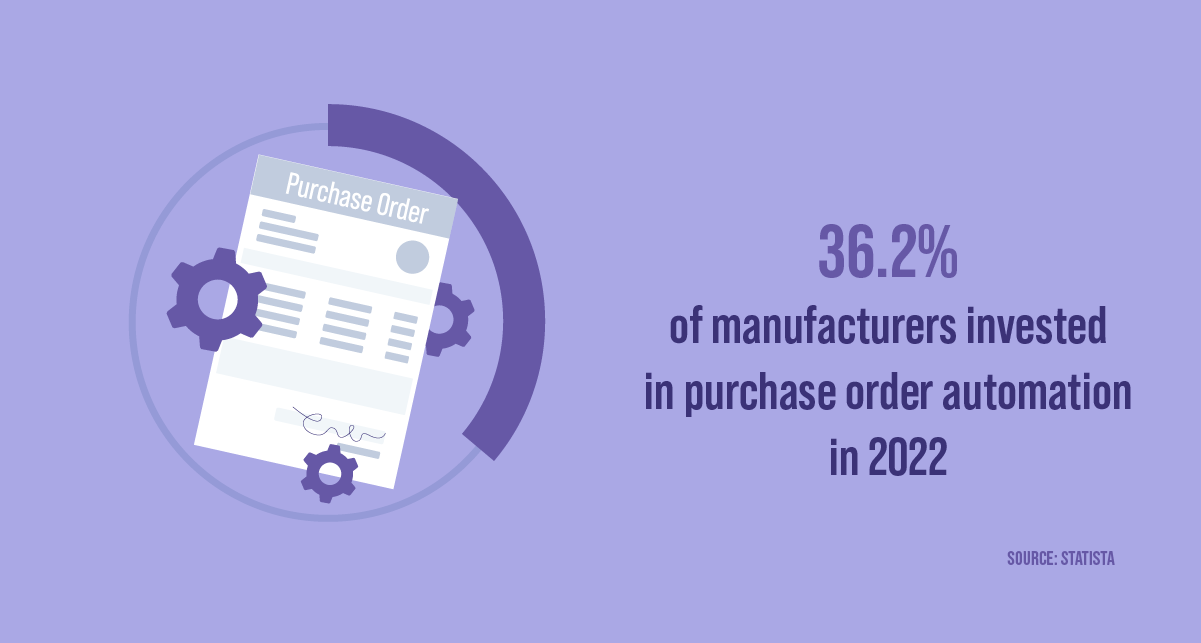
These businesses are implementing technologies to digitize and optimize the PO process by streamlining manual tasks, improving data visibility, and reducing errors and fraud. Some of the PO processes that can be automated include:
- Purchase requisition creation and approvals
- Purchase order creation
- Invoice processing
- Three-way matching
- Inventory management
- Payment processing
- Vendor management
- Spend reporting and analytics
There are two paths to PO automation. Companies that want to overhaul their purchasing processes can automate everything at once by implementing an end-to-end PO management solution. Companies preferring a more gradual, flexible approach to PO automation can start by automating key functions with a point solution. For example, a company may implement an AP automation platform to streamline its invoice processes and later add integrated or modular solutions for PO processing or payments. Whatever path you choose, automating P2P processing can significantly benefit your organization.
Top 5 benefits of purchase order automation
Let’s unpack the top five benefits of using an automated purchase order system.
1. Cost and time savings
PO automation saves your business time and money by eliminating inefficient manual purchase order processes, minimizing costly errors, and improving spend management. For example, Alden Renewables reduced labor costs by $150-200,000 per year by automating purchase order management with Stampli.
2. Improved vendor relationships
Automated systems reduce purchase order errors and late payments that damage vendor relationships by improving processing efficiency and accuracy. Vendor engagement solutions like Stampli’s Advanced Vendor Management simplify vendor communications and document management.
3. Faster procurement cycle
Automated PO processing reduces the time to prepare, create, approve, and issue purchase orders, ensuring timely and accurate delivery of products and services and fast payment processing.
4. Better visibility into spend
Automating PO processing lets you capture and analyze real-time KPIs and spend metrics. With greater visibility into your spending, you can optimize vendor selection to reduce costs, improve cash flow management, and monitor spending by department or category.
5. Strengthen controls and compliance
Purchase order automation enables you to set user permissions, establish approval routing policies, maintain a complete audit trail, and enforce expense policies. You can prevent unauthorized spending and fraud by controlling who can submit and approve purchases and payments, restricting purchases to approved suppliers, and enforcing financial controls.
With these benefits in mind, let’s look at the steps to automate your purchase order process.
How to automate purchase order processing
Automating the PO process involves identifying which manual tasks can be automated and implementing solutions to automate them. Every company is different, but the basic PO process follows seven steps:
- Purchase initiation and approval
- Supplier selection and negotiation
- Create purchase order
- Delivery and receipt
- Invoice processing
- Three-way matching
- Invoice approval and payment
We’ll use a fictional example to illustrate each step and explore how it can be automated. Our fictional company, BTB Confections, is a candy producer. BTB is experiencing rapid growth and needs to update its manual P2P processes.
1. Purchase initiation and approval
The procurement process begins when a department identifies it needs a good or service. In our example, BTB’s production department needs to order lemon flavoring to make lollipops. The production manager manually creates a purchase requisition and emails it to their director for approval. After the director approves the requisition, the production manager forwards the email to the purchasing department.
How purchase requisitions can be automated
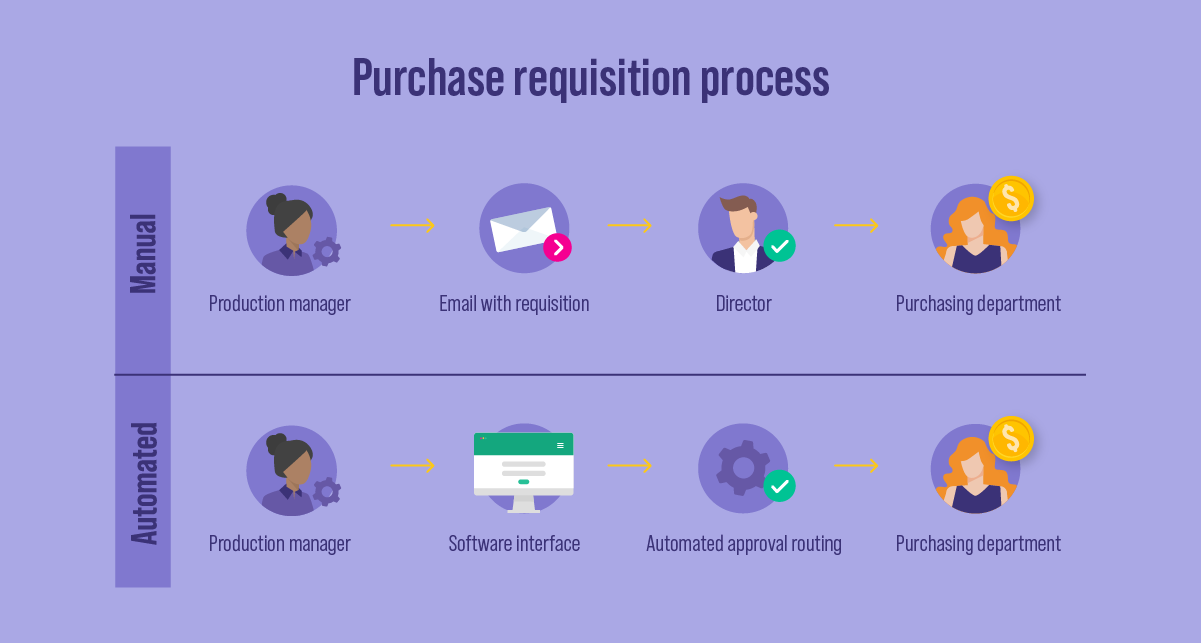
Manually creating and sending purchase requisitions is slow, and mistakes happen. For example, the purchasing department may miss the emailed requisition for lemon flavoring, resulting in delayed delivery and disrupting lollipop production.
Purchasing software automates the requisition creation and approval process to ensure requisitions are accurate and are routed to the correct approver. It automatically reminds approvers of pending requisitions, ensuring that purchases are approved promptly and production isn’t delayed. Once the requisition is approved, the software automatically notifies the requestor and forwards the approved requisition to the purchasing department.
2. Supplier selection and negotiation
Once the purchasing department receives the approved purchase requisition, they select a supplier for the purchase. First, the purchaser checks the list of approved suppliers for lemon flavoring. If there is an approved supplier, the purchaser confirms the price and terms and creates and issues a purchase order (Step 3).
If there isn’t an approved supplier for the purchase, the purchaser identifies and selects a new supplier, negotiates the price and terms, and then onboards the supplier. Once the supplier is onboarded, the purchaser creates and issues a purchase order.
How supplier selection and negotiation can be automated
Checking approved supplier lists and onboarding new suppliers is time-consuming and leaves room for error. For example, the approved supplier list may be outdated, or vendor onboarding may be delayed if vendors don’t provide the required information or documents.
Vendor management and procurement automation solutions automatically check purchase requisitions against approved supplier lists. Solutions like Stampli’s Advanced Vendor Management streamline new vendor onboarding by letting suppliers register and provide their information and documentation through an online portal. Vendor management solutions also manage a centralized supplier database, making it easy to maintain updated supplier lists.
3. Create and issue a purchase order
After negotiating pricing and terms and onboarding a new vendor if needed, BTB’s purchasing department creates a paper purchase order for the lemon flavoring. The purchasing manager signs the PO, scans it to a PDF, and then emails the PDF to the supplier.
How to automate creating and issuing purchase orders
Manually completing a paper purchase order, scanning it, and emailing the scanned PO to a supplier is slow and leaves too much room for error. If the purchase order contains incorrect information or the email gets misdirected or lost, the shipment may be delayed or BTB may receive the wrong quantity or type of product.
Procurement automation software streamlines PO creation by automatically populating the PO with vendor information, line details, categories, and other information. Some platforms enable purchasing departments to automatically send POs to suppliers through a vendor portal or by email, ensuring timely delivery.
4. Delivery and receipt
Once the supplier receives the PO for the lemon flavoring, they package the order, itemize the shipment on a shipping receipt, and ship the order to BTB’s production facilities. When the order arrives, BTB’s inventory manager receives the shipment, inspects it to ensure it meets the specifications in the PO, records the shipping receipt, and adds the lemon flavoring to BTB’s inventory.
After the order has been shipped, the supplier mails an invoice to BTB’s accounts payable department.
How PO automation improves delivery and receipt
BTB’s reliance on paper-based shipping processes slows down the receiving process and puts them at risk of shipping errors. For example, when a shipment arrives, BTB’s receiver must manually compare each paper shipping receipt to the associated PO to ensure that the shipment contains what was ordered. If either document is lost or damaged, they may not be able to confirm the shipment, which can cause delays while they work with the vendor to investigate.
By digitizing POs and shipping documents, PO automation solutions make it easier for receivers to quickly confirm and accept shipments. They also facilitate efficient three-way PO matching by providing accurate, timely, and accessible data.
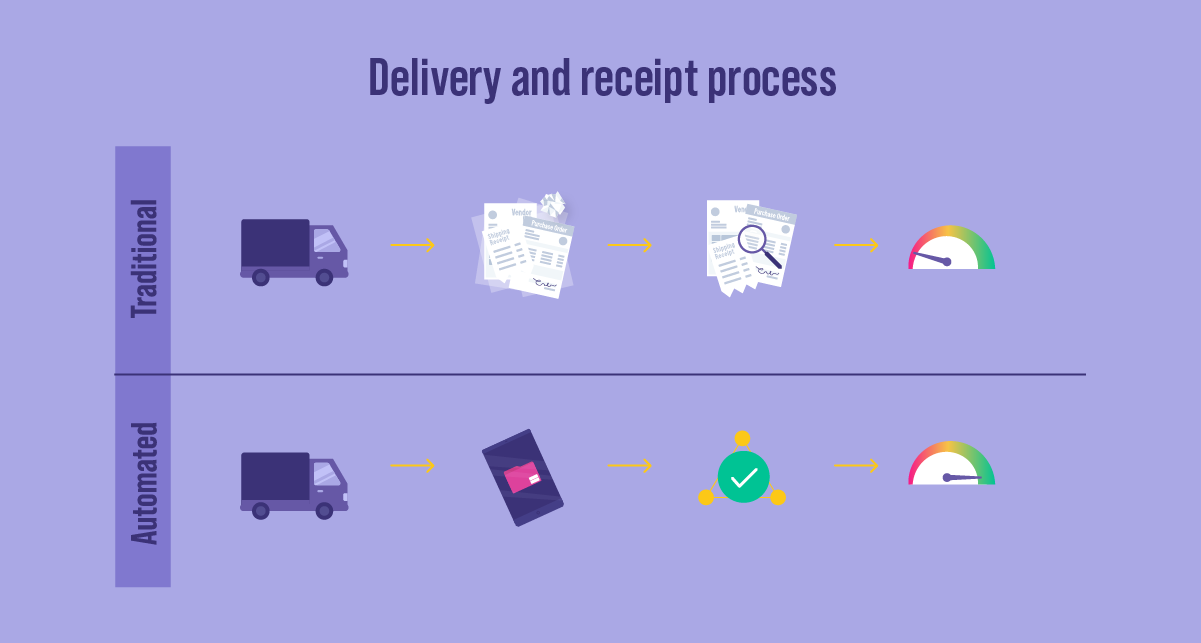
5. Invoice processing
After they ship the lemon flavoring, the supplier mails a paper invoice for the shipment to BTB’s accounts payable department. When the invoice arrives, one of BTB’s AP clerks manually enters the invoice details into the accounting system, looks up the general ledger code for lemon flavoring, and assigns the code to the line item on the invoice.
How PO automation streamlines invoice processing
Paper-based invoice processing may be adequate for small businesses with a low volume of invoices, but it quickly becomes unsustainable as your business grows. Manually receiving, entering, and coding invoices takes time and is prone to human error. Paper invoices can get lost, invoice details can be entered incorrectly, or the wrong GL codes could be applied, slowing down processing and exposing the business to financial risk.
Leading AP automation platforms use OCR and AI technologies to streamline invoice data entry and GL coding. They automatically capture and categorize invoice data, making invoice processing faster and more accurate. Platforms like Stampli synchronize invoice data with ERPs, accounting software, and other business systems to ensure data consistency across the organization.
6. Three-way matching
After BTB’s AP clerk has entered and coded the invoice details, they match the invoice against the purchase order and shipping receipt to ensure the billing details match what was ordered and shipped. If the three documents match, the clerk forwards the invoice to the finance director for approval. If the details don’t match, the clerk investigates and attempts to resolve the discrepancy before sending the invoice for approval and payment.
How PO automation makes three-way matching more effective
Manually comparing invoices, POs, and shipping receipts is time-consuming, especially when AP employees must make line-by-line comparisons for large and complex orders. To save time, many companies only perform three-way matching on high-value purchases and rely on two-way matching to confirm the remaining purchases.
Some ERPs and procurement platforms feature automated three-way matching capabilities. These tools can perform basic rules-based matching, such as identifying discrepancies between quantities and prices between documents. However, because they are rules-based, they require exact matches between invoice, PO, and receipt details. Even minor differences between documents can prevent matching. For example, if the line item on a purchase order reads “Lemon flavoring,” but the corresponding line item on the invoice reads “Natural lemon flavoring,” the rules-based matching tool may not recognize that both descriptions refer to the same product. The tool will indicate a discrepancy, forcing AP employees to investigate and manually perform the match.
Stampli AI Line-Level PO Matching and Cognitive AI™ PO Matching solutions use advanced AI technology to make PO matching easier and more accurate. AI Line-Level PO Matching automatically identifies exact matches between header and line-level PO data and flags discrepancies when they don’t match. It automatically skips invoice approvals if POs and invoices match, speeding up invoice processing while ensuring accuracy.
Cognitive AI PO Matching incorporates business logic to understand the full business context of POs, invoices, and shipping receipts. It can understand and process complex matching scenarios such as inconsistent item descriptions, quantity mismatches, and split deliveries. It reaches the same matching conclusions as human operators 97% of the time and always improves as it learns. With Cognitive AI, BTB can truly automate three-way matching for every transaction, preventing errors and fraud and freeing its AP employees to focus on higher-value tasks.
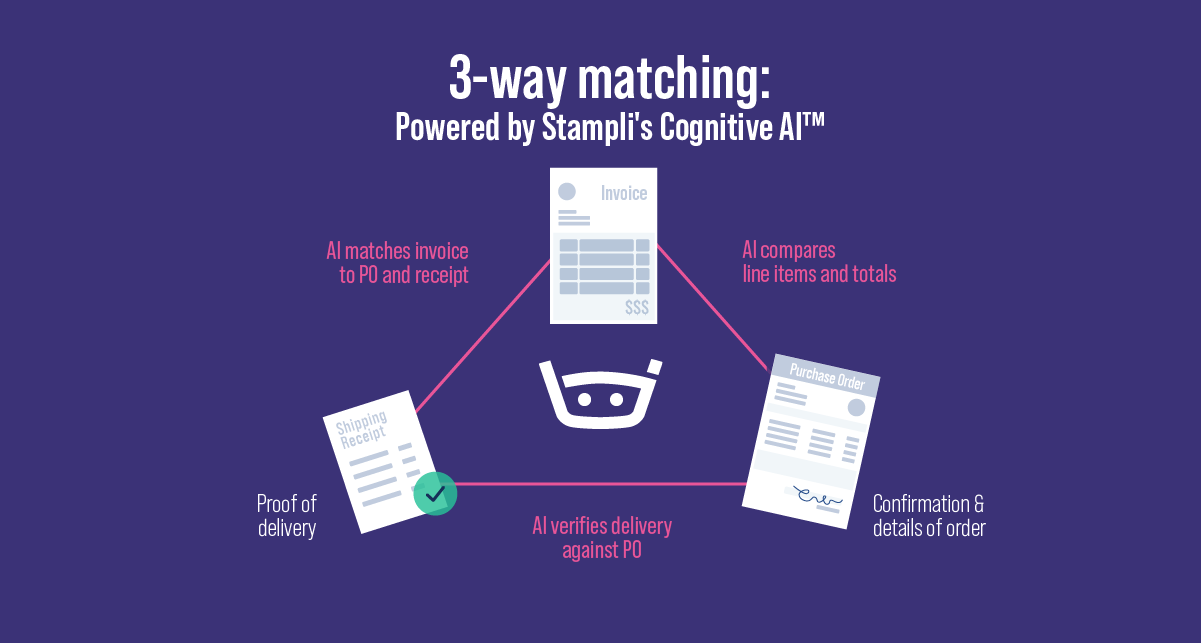
7. Invoice approval and payment
Once BTB’s AP team verifies the invoice against the PO and shipping receipt, they email it to the finance director for approval. The director approves the invoice and returns it to the AP clerk, who processes it for payment. BTB pays the invoice by check or ACH transfer depending on the vendor’s preference. After paying the invoice, the clerk records the payment in the accounting system.
How automation facilitates fast and accurate approvals and payments
Like its other manual processes, BTB’s manual invoice approval and payment process exposes the company to delays and risks. Payments can be missed or delayed if the finance director misses, loses, or forgets the approval email. Additionally, although the AP clerk is using an accounting system, they can still make mistakes when they manually pay the invoice.
AP automation software automatically routes verified invoices to the appropriate approver for review and sign-off and sends reminders if they don’t approve the invoice within a certain time. Automation platforms offer several options for invoice payments. Some platforms are payments first — they offer payment features and only include AP and procurement automation as an afterthought. Others only provide minimal integrations with ERPs to perform payment automation but can’t support other complicated P2P processes.
Leading platforms like Stampli give AP teams more flexibility. Stampli Direct Pay and Stampli Card integrate with Stampli’s core platform to provide comprehensive AP and payment automation. Stampli’s integrations also support full native functionality for over 70 ERPs, accounting platforms, and business systems, ensuring you’ll never have to compromise ERP functionality to automate P2P workflows.
How to choose and implement a purchase order system
Implementing a new PO automation system can seem challenging, but taking a strategic four-phase approach can make the process a lot easier.
- Evaluate current PO processes and areas for improvement.
- Set automation goals and priorities.
- Select and implement PO automation solutions.
- Train staff on the new automation system.
Let’s take a brief look at each phase.
Phase 1: Evaluate current PO processes and areas for improvement
Begin by mapping your current PO workflows. Flag any bottlenecks, manual processes, and areas where errors occur. Doing this will help you focus on appropriate solutions and provide a roadmap for successful implementation.
Phase 2: Set PO automation goals and priorities
After evaluating your current processes, work with stakeholders to decide what you hope to achieve through PO automation. For example, do you want to reduce invoice errors, gain better visibility into expenditures, expedite supplier deliveries, or reduce processing time? Reducing these complex, labor-intensive tasks frees your employees to focus on work that only humans can do (such as interacting with vendors). It also frees your finance department so it can do what matters most — providing financial insights and advice to help your business make informed strategic decisions.
Identifying processes and tasks you don’t want to automate is just as important. This list should include decisions and tasks where human oversight is required. For example, if you opt for automated invoice coding, you may want to include a step for a human employee to verify the system’s recommendations.
Phase 3: Select and implement purchase order software
Research different PO automation solutions to determine the best fit for your business. Consider your business size and specific needs:
- Are you looking for a comprehensive end-to-end solution? Do you prefer the flexibility of multiple integrated point solutions?
- Does the solution offer the functionality you need? Is it scalable to handle increased PO volumes as your business grows?
- Does the pricing suit your budget?
- Does the solution provider offer pre- and post-implementation support?
- Will the solution integrate with your existing systems without compromising functionality?
Phase 4: Train staff on the new automation system
Good training can help overcome staff resistance to the new automation system and ensure a successful adoption. Provide comprehensive training for your teams and offer ongoing support to address any challenges or obstacles that may arise. Likewise, if the new automation solution will impact suppliers, give them plenty of heads up on the changes to minimize disruptions to orders and payments.
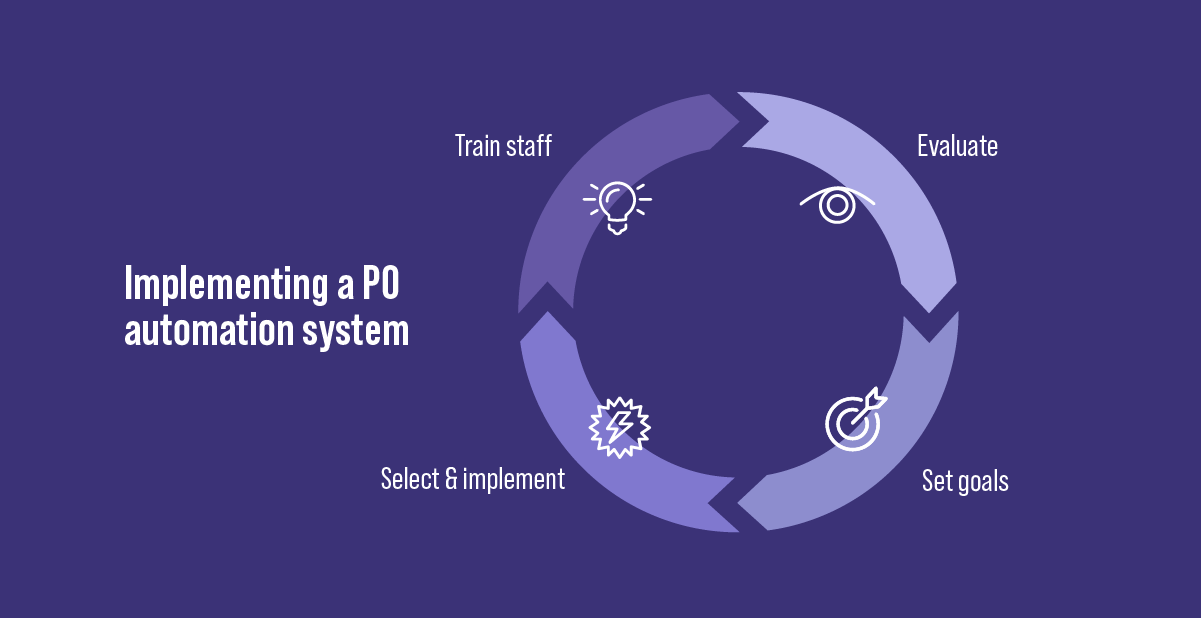
Stampli’s Cognitive AI™ for automated PO matching
Stampli’s Cognitive AI for PO matching is a groundbreaking solution that fully automates purchase order matching — significantly reducing manual effort and providing 97% human results efficiency.
Powered by Large Language Models (LLMs), the most comprehensive AP datasets, and expertly mapped business logic, Cognitive AI quickly learns your processes and preferences to perform work on your behalf while giving you oversight and control. It understands the nuances of invoice matching and replicates human judgment and decision-making processes.
AI that can reason, not just match
Stampli’s Cognitive AI understands context and can work through problems like a human, allowing it to match invoice, PO, and shipping receipt details better than any other solution.
Flexibility for any PO environment
Cognitive AI for PO Matching supports 2-way and 3-way matching, blanket POs, taxes, freight, and other complex requirements.
The only finance operations platform centered on AP
Founded in 2015, and with millions of hours of customer labor saved, Stampli has more AI experience than other finance operations platforms. It stands above the market as the only finance operations platform centered on accounts payable. Stampli is designed by AP experts to enhance efficiency across the entire procure-to-pay cycle and create breakthrough productivity for AP and finance teams. Stampli automates all manual activities using Billy the Bot™, the industry’s leading AI copilot. Billy saves Stampli’s 1600+ customers millions of hours of labor by automatically processing $85B+ invoices every year.
Thanks to pre-built integrations for ERPs like Microsoft, Oracle, Sage, SAP, QuickBooks, Acumatica, Dealertrack, and many others, Stampli fully adapts to your existing finance processes and ERP configuration. Stampli implements within weeks, not months, and is easy for employees, vendors, and stakeholders to learn.
Ready to free yourself from manual PO matching? Contact a Stampli PO automation expert today to see Cognitive AI in action.